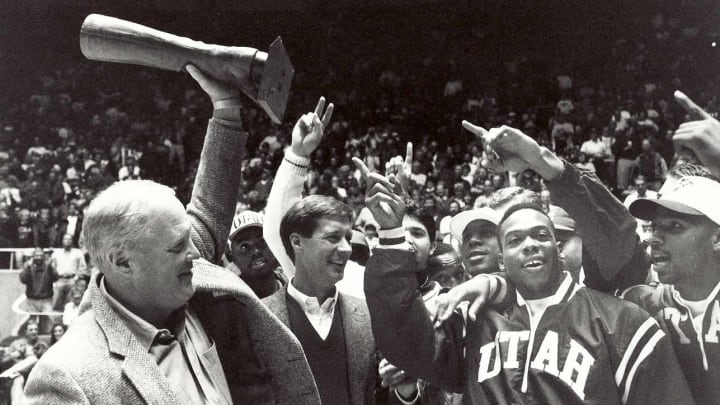The Murky Future of the Beehive Boot, College Football's Strangest Rivalry Trophy

There’s Paul Bunyan’s axe, a live pig, a canon, a variety of gold-plated this and that. College football is known for its trophies, which range from pedestrian to bizarre to living and breathing—and many of them will be awarded this week.
Trophies are endlessly fun to analyze, to delve into histories and rank by any number of metrics. Two years ago on SI.com, we ranked 64 different prizes, from most to least unusual—which wouldn’t be so noteworthy, except that the strangest trophy in the game wasn’t mentioned once.
In the leadup to rivalry week, I started to investigate the Holy War, which is the name BYU and Utah would rather you not use to describe their Saturday-night matchup. This season, the game’s stakes are low; the Utes are No. 18 in the latest AP Poll, and BYU hasn’t been ranked since Week 5. In fact, going into the season’s final week, the AP's highest-ranked team from the state of Utah is neither the state’s Pac-12 representative nor its storied independent; it’s 10–1 Utah State, which is No. 14 (the Utes are, however, four spots higher than the Aggies in the College Football Playoff rankings). The Aggies defeated BYU soundly, 45–20, in Week 6, but they won’t get a crack at the Utes this season—and as a result, the Beehive Boot, the trophy of all trophies, will go another season without being awarded.
STAPLES: Ranking Rivalry Week's Five Most Hate-Filled Games
Yes, the Beehive Boot. No actual bees are involved; the boot gets its name from Utah’s nickname, the Beehive State, which comes from the fact that the state is shaped like a… wait. No it’s not. Utah is essentially a square with a fat smokestack protruding from its northwest side. Let’s try this again: Utah is called the Beehive State because beehives symbolize industry and hard work, two pillars of the state’s identity and the Mormon Church.
This is already getting convoluted. Anyways: Around 1970, BYU’s former sports information director decided the state should have some kind of codified football rivalry. It needed a trophy, obviously, and a consensus was reached that this trophy should be an authentic pioneer boot (which, to be clear, no bees had ever inhabited). It turned out to be easier said than done, though: pioneers didn’t stop at Frye every season for an up-to-date pair. Most of their boots were worn within an inch of disintegrating before they presumably abandoned what was left of them in the desert. But in 1971, an antiques dealer from Utah’s Cache Valley—near Moab—came up with a pair of bonafide pioneer boots, in decent shape. One of them—it’s unclear where the other went, or if it’s in waiting for when the current one collapses—would serve as the prize in a rivalry between four of the state’s universities: BYU, Utah, Utah State and Weber State.
Weber State, an FCS program that’s been one of the lower tier’s best teams since 2016, rarely played against the other three, and it never won the boot. In fact, it was included in the competition only to get more games into the equation—and it was disqualified from the rivalry at some point in the 1980s, although no one is sure exactly when. That, I learned over several days of emailing and Reddit-diving, is a common theme when it comes to the boot and its story: yeah, we’re not sure exactly why, or when.
Beehive Boot #utahstatechamps pic.twitter.com/hLRYcvFZJ0
— AggieUp (@AggieUp) October 12, 2014
Currently, the Beehive Boot lives on Utah’s campus. This, at least, we know; Utah’s SID confirmed it on Sunday. In 2016, the Utes defeated BYU, 20–19, and finished 9–4. That year, Utah State had just three wins and lost to BYU, 28–10. It never faced Utah, but somehow, this result was enough to send the boot to Salt Lake City. Sure, Utah State didn’t deserve consideration, but BYU finished with the same record as Utah. O.K., then: That head-to-head matchup, the Utah win, decided the boot. It makes enough sense.
What happened next makes less sense. In 2017, Utah defeated BYU, 19–13. BYU also lost to Utah State, 40–24. Logically, it would have been out of the running for the boot, having gone 0–2 among the in-state teams, just as Utah State had the year before. Meanwhile, both Utah and Utah State were 1–0, with wins over BYU, and instead of deciding the boot by some other metric, it simply wasn’t awarded on the grounds that all three teams hadn’t played one another—even though that had been the case the previous year. It was the first year in the boot’s history that it wasn’t awarded—despite it being the 11th time since its inception that the round-robin of the three teams wasn’t complete.
Consider this, too: The rules of the boot allow for a media vote in the case of a tie. In years when all three teams play and are 1–1 in the round robin, a voting panel comprising each school’s play-by-play announcer and beat writers awards the boot. (Notably, in the four years when the boot came down to a vote, Utah State won each time.) So clearly, there’s a mechanism for solving the boot’s winner, rather than just landing at a stalemate, but since 2016, anarchy has reigned. Utah got the boot without a consensus or a vote, and then it kept the boot, and now, word from the Beehive State is that the boot will stay retired in 2018.
LITMAN: Jim Tressel and the Unintentional Guarantee That Flipped Michigan-Ohio State
There’s one way, it seems, that the boot might come out of its hiatus this year: If the Utes and the Aggies meet in a bowl game, which is possible, if not probable. Otherwise, the boot may remain on Utah’s campus indefinitely; Utah State has no looming nonconference matchups with the Utes, although the Aggies are on BYU’s slate through 2022.
So is that it, then—Utah keeps a boot that it won in 2016 in perpetuity, because for no explicable reason, the rules changed? If anyone is worried about the boot wearing out—it’s an antique, after all—there’s the mysterious other half to the pair, the right-foot boot. (How did they decide to award the left in the first place?) Trade it out, if that’s the problem.
Ultimately, the boot seems like something casually exchanged during another era of football, when some years, one school would forget to exchange it with the new winner for the good part of a season—and when conference realignment hadn’t yet made the Utah schools’ meetings so tough to schedule. Still, the schools went through all the trouble to find the antique, to place it in a glass case and chisel a plaque and come up with a name that’s as catchy as it is confusing. It’s the perfect fodder for rivalry-week storytelling, bizarre and uniquely drawn from Utah’s history. But unlike other rivalry trophies, it’s oddly arbitrary. Media, vote on it! This year, never mind. The rules are hazy—which might be the best thing about the Beehive Boot, which will fall more and more into football obscurity with every year it’s not awarded.
